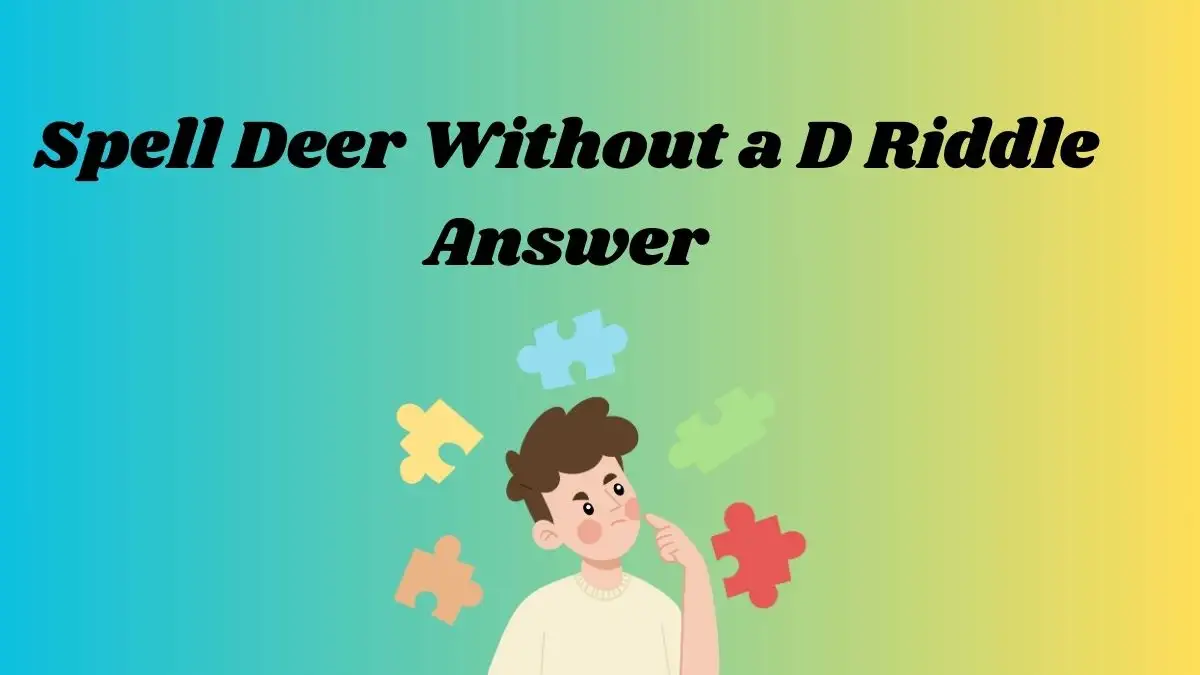Spell Deer Without a D Riddle Answer and Explanation
by Kowsalya
Updated Sep 28, 2024

Welcome to the world of riddles! Here, you’ll find a variety of intriguing riddle questions along with their answers. Visit our website daily for fresh riddle clues and updates. Challenge your mind and use your brainpower to uncover the solutions. If you're seeking answers to tricky riddles, our site is your go-to resource. We provide not only the answers but also insightful strategies and detailed explanations to help you crack each riddle.
Spell Deer Without a D Riddle Answer
Its EER or EAR
Spell Deer Without a D Riddle Explanation
The riddle "Spell 'deer' without a 'd'" plays on the letters in the word "deer." When you remove the letter 'd,' you're left with the letters 'e,' 'e,' and 'r,' which can be read as "EER." Alternatively, if you take the first two letters 'de' out, you're left with 'eer,' or simply keep 'ear' from the original letters. Thus, the answer can be expressed as either "EER" or "EAR."
Riddles
Riddles are clever puzzles or questions designed to challenge the mind and encourage critical thinking. They often involve wordplay, metaphors, or hidden meanings, making the answer less obvious at first glance.
Riddles come in two main forms: enigmas, which are metaphorical or allegorical puzzles requiring creative thinking, and conundrums, which are based on wordplay or puns. Solving riddles requires lateral thinking, as the solutions may not be immediately clear or logical. Riddles have been used for entertainment, education, and even cultural storytelling for centuries, engaging people of all ages in playful problem-solving and mental exercises.
How to Play Riddles?
- Listen or read the riddle carefully.
- Think about it creatively, as riddles often have hidden clues or tricky wording.
- Break the riddle into parts to understand what it's asking.
- Make a guess based on your thoughts.
- Check your answer, and if it's not correct, try again!
Recent Articles
- Puzzle IQ Test: Only 5 Out of 10 Can Spot the 5 Hidden Words in this Image in 10 Secs
- Optical Illusion Eye Test: If You have Hawk Eyes Spot the Odd Flower in 5 Secs
- Odd One Out Puzzle: Only eagle Eyes Can Spot the Odd Elephant in 7 Secs
- Optical Illusion Eye Test: If You have Hawk Eyes Spot the Odd Grapes in 7 Secs
- Puzzle IQ Test: Only 5 Out of 10 Can Spot the 5 Hidden Words in this Image in 10 Secs
- Optical Illusion Eye Test: If You have Hawk Eyes Spot the Odd Baby in 7 Secs
- Odd One Out Puzzle: Only eagle Eyes Can Spot the Odd Sunflower in 7 Secs
- Optical Illusion Eye Test: If You have Hawk Eyes Spot the Odd Turtle in 5 Secs
- Puzzle IQ Test: Only 5 Out of 10 Can Spot the 5 Hidden Words in this Image in 10 Secs
- Optical Illusion Eye Test: If You have Hawk Eyes Spot the Odd Ball in 7 Secs
- Odd One Out Puzzle: Only eagle Eyes Can Spot the Odd Watermelon in 7 Secs
- Optical Illusion Eye Test: If You have Hawk Eyes Spot the Odd Skunk in 7 Secs
- Puzzle IQ Test: Only 5 Out of 10 Can Spot the 5 Hidden Words in this Image in 10 Secs
- Optical Illusion Eye Test: If You have Hawk Eyes Spot the Odd Dog in 7 Secs
- Odd One Out Puzzle: Only eagle Eyes Can Spot the Odd Elephant in 5 Secs
- Optical Illusion Eye Test: If You have Hawk Eyes Spot the Odd Cherry in 5 Secs
- Puzzle IQ Test: Only 5 Out of 10 Can Spot the 5 Hidden Words in this Image in 10 Secs
- Optical Illusion Eye Test: If You have Hawk Eyes Spot the Odd Cat in 7 Secs
- Optical Illusion Eye Test: If You have Hawk Eyes Spot the Odd Cupcake in 5 Secs
- Odd One Out Puzzle: Only eagle Eyes Can Spot the Odd Mango in 5 Secs
- Optical Illusion Eye Test: If You have Hawk Eyes Spot the Odd Apple in 5 Secs
- Odd One Out Puzzle: Only eagle Eyes Can Spot the Odd Teddy Bear in 5 Secs
- Puzzle IQ Test: Only 5 Out of 10 Can Spot the 5 Hidden Words in this Image in 10 Secs
- Optical Illusion Eye Test: If You have Hawk Eyes Spot the Odd Hen in 5 Secs
- Puzzle IQ Test: Only 5 Out of 10 Can Spot the 5 Hidden Words in this Image in 10 Secs




